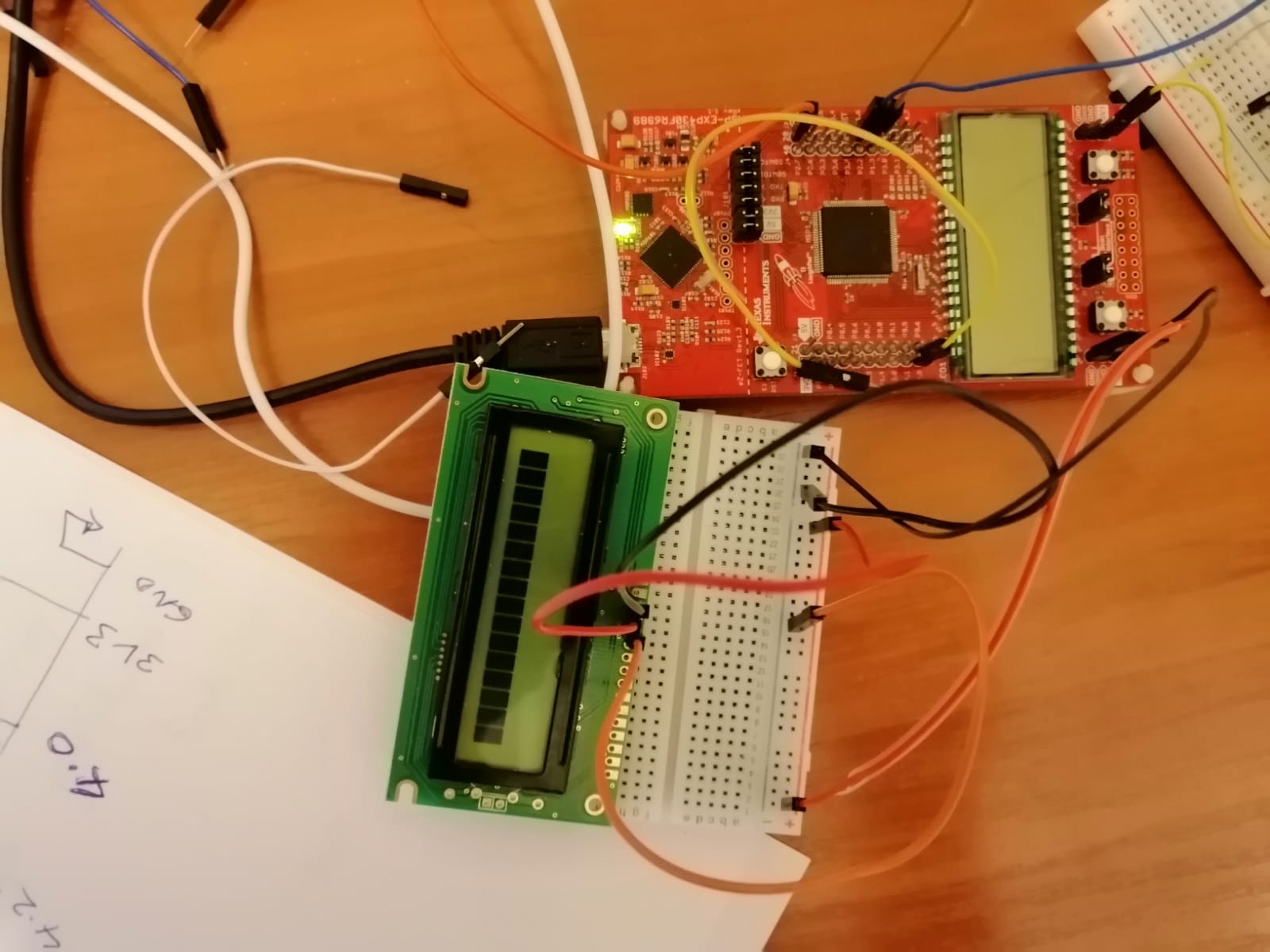I am trying to program an interface between my 2x16 LCD and my MSP430FR6989.
The LCD communicates parallelly with the MPU (E RS EW D7 -- D0), and it uses an ST7066U controller IC.
from reading the datasheets of the LCD and the IC this is what I understood.
- When powered on we need to wait for 40 ms before the user software take further initialization steps
- When writing instruction or data, we need to enable E, create a time delay of at >= 0.4us then clear E in order for the data or ins to register into the IC.
- Before writing data or instruction, we need to check if Busy Flag is cleared (RS = 0 RW = 1, check DB7), however, we need to wait for at least 80 us before checking the BF, and at that time E needs to be low.
Pseudo code
RS = 0
RW = 1
E = 1
start_1us_delay();
E = 0;
start_80us_delay();
while(time < 80us)
{
if(BF_Pin == 1)
//IC BUSY
else
//IC is not Busy
}
- The initialization steps, after waiting for 40 ms, configure the Function Set register, wait for 40us, configure the Function Register again, wait for 40us, send Turn On Display command, wait for 40us, send Display Clear command, wait > 2ms, send Entry Mode Set command, wait > 2ms
Page 23/42 of the ST7066U datasheet
before each of the last 3 commands we need to check if BF is set or cleared
send a data, we check the status of the BF, if cleared, then write the data
Given all the information about the ST7066U controller, I created this code:
main.c
#include <msp430.h>
#include "LCD.h"
int main(void)
{
WDTCTL = WDTPW | WDTHOLD; // stop watchdog timer
PM5CTL0 &= ~LOCKLPM5;
initLCD ();//EDIT 1
checkBF();
write('A');
while(1);
return 0;
}
LCD.c
#include <msp430.h>
#include "LCD.h"
//fSMCLK = 1MHz t = count*TSMLK, count = t*fSMCLK
#define DELAY_40MS 40000//count = 40 * 1000
#define DELAY_40US 40// 40 * 1
#define DELAY_2MS 2000//2000 * 1
#define DELAY_1US 1// 1 * 1
#define DELAY_80US 80// 80 * 1
//for debugging purposes
unsigned int E_Pin = 0;
unsigned int RS_Pin = 0;
unsigned int RW_Pin = 0;
unsigned int BF = 0;
//DB0 DB1 DB2 DB3 DB4 DB5 DB6 DB7 E RW RS Vo Vcc Vss
//4.3 9.6 9.5 9.4 9.3 9.2 9.1 9.0 4.2 4.1 4.0 Vcc Gnd
void initGPIO (void)
{
P9DIR = 0xFF;//output
P4DIR = 0xFF;//output
P4OUT = 0x00;
P9OUT = 0x00;
}
//counts to 0xFFFF then resets and count again, clock source from SMCLK
void initTMR (void)
{
TA0CTL |= (MC__CONTINUOUS | TASSEL__SMCLK);
TA0CTL &= ~TAIFG;
}
//SMCLK = 1Mhz DCOCLK
void configClock (void)
{
CSCTL0 = CSKEY;
CSCTL1 = 0x0000;//DCO 1MHz
CSCTL2 |= (SELA__LFXTCLK | SELS__DCOCLK | SELM__DCOCLK);
}
void delay(unsigned int tmr)
{
TA0R = 0;
while(TA0R < tmr);
TA0CTL &= ~TAIFG;
}
//RS = 0, RW = 1, E = 1, delay for 1 us
//E = 0, delay for 80us,
//while at this delay check the status of BF
void checkBF (void)
{
unsigned int BF;
RS(0);//Inst
RW(1);//Read
do
{
E(1);
delay(DELAY_1US);
E(0);
TA0R = 0;
while(TA0R < DELAY_80US)
{
if(P4OUT & BIT3)//BF = 1
BF = 1;
else
BF = 0;
}
}while(BF);//loop while BF is set (IC busy)
}
void initLCD (void)
{
initGPIO ();
configClock ();
initTMR ();
E(0);
delay(DELAY_40MS);//wait for 40ms
command (0x38);//Function Set 8-bit, 2-line, 5x8
delay(DELAY_40US);//40us
command (0x38);
delay(DELAY_40US);
checkBF();
command (0x0C);//Display ON
delay(DELAY_40US);
checkBF();
command(0x01);//Clear Displayt
delay(DELAY_2MS);
checkBF();
command(0x07);//Entry Mode Set
delay(DELAY_2MS);
}
void command (char ch)
{
outputPORT(ch);
RS(0);//Ins
RW(0);//Write
E(1);
delay(DELAY_1US);//PW >= 450 ns
E(0);
delay(DELAY_1US);
}
void write (char ch)
{
outputPORT(ch);
RS(1);//Data
RW(0);//Write
E(1);
delay(DELAY_1US);
E(0);
delay(DELAY_1US);
delay(DELAY_40US);//write data needs a delay of 40us
}
void outputPORT (char ch)
{
P9OUT = (ch & 0x7F);
ch = ch >> 4;
P4OUT |= (ch & 0x08);
}
void RS(int i)
{
if(i == 1)
{
P4OUT |= BIT0;
RS_Pin = 1;
}
else
{
P4OUT &= ~BIT0;
RS_Pin = 0;
}
}
void RW(int i)
{
if(i == 1)
{
P4OUT |= BIT1;
RW_Pin = 1;
}
else
{
P4OUT &= ~BIT1;
RW_Pin = 0;
}
}
void E (int i)
{
if(i == 1)
{
P4OUT |= BIT2;
E_Pin = 1;
}
else
{
P4OUT &= ~BIT2;
E_Pin = 0;
}
}
However when I run the code and debug, I don't see anything being displayed, just the first line being black (which indicates that the Hardware configuration is working).
Kindly help me with this issue.
EDIT 1
This is a picture of the LCD to MPU connections, I removed the other jumper wires, and left the Vss connected to GND, Vdd connected to +5.0V, and Vo (contrast) connected to GND.


